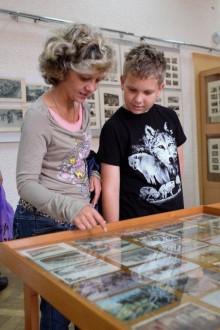The exhibition marks the 100th anniversary of the World War I, featuring little icons in boxes, matchbox-sized German-French and German-English dictionaries, inscribed soldiers’ cups, order medals, documents, plates with portraits of the Austrian emperor, various lesser medals, photographs of everyday life in wartime, postcards, century-old paintings, and much more. The exhibition is so extensive and spectacular that it puts high demands on the visitor’s attention and time. The museum’s employees prepared the exhibition using items from the collection of renowned local historian, author, Honored Master of Folk Art of Ukraine Ivan Snihur.
“I worked on it for 60 years,” Snihur told us. “I did not intend it for show, it being just a private collection. I present only part of it now. Most of the collected items have not been put on display, particularly soldiers’ letters, documents, rare photographs...”
It is a truly frightening experience – to tour a war-themed exhibition at a time when eastern Ukraine is engulfed in deadly fighting.
Chernivtsi was thrice occupied by Russian troops during the World War I (September 2, 1914 till October 20, 1914; November 27, 1914 till February 17, 1915 and June 18, 1916 till August 3, 1917). The Russians began to implement their plan to take the city on September 2, 1914. According to documents, on taking Chernivtsi, Russian soldiers committed mass robberies of abandoned private homes with impunity, especially on the outskirts of the city. Cossacks displayed extreme arrogance, breaking into apartments under pretext of conducting searches, and then demanding ransom. Resisting citizens lost their personal property. Soon, the Cossacks were openly offering clothes, fine underwear, expensive tableware sets and other loot for sale at the city’s Rynkova Square.
“It was a sad time,” outstanding Bukovynian writer Olha Kobylianska wrote, “when the enemy occupied the city of C. [Chernivtsi] in Bukovyna. Following the broad flow of enemy troops, including infantry, cavalry, and then Cossacks, their wagon train and munitions column dragged into the city as well... They did not come here to defend their country from a devastating attack of the enemy, but, as they said, ‘to liberate Slavs’ at the command of their tsar...”
In view of the developments in Chernivtsi during the World War I, speakers at the exhibition’s opening drew parallels between them and the ongoing events in eastern Ukraine. This point, in particular, was stressed by the well-known historian and political scientist Ihor Burkut.
“The exhibition includes photographs, postcards and some Austrian and Russian documents. On taking a close look at the documents, we see that the Russians denied the Ukrainians’ existence a century ago as strongly as now. When Russian troops occupied Chernivtsi in early September 1914, a Russian general went on the steps of the city hall and said: ‘From now and for all times, Chernivtsi will be a Russian city!’ They robbed, raped, killed innocent people a century ago, and they are doing the same now in the east of Ukraine. Unfortunately, nothing has changed over the intervening century. No wonder that modern Russia stubbornly calls the World War II the Great Patriotic War, despite it having nothing to do with defending the homeland and everything to do with annexation of foreign lands! The World War I saw about 10 million people killed and 10 million wounded... We need to carefully keep track of what is happening today in eastern Ukraine. Those who unleash wars will be punished!”
Photo courtesy of the exhibition’s organizers







